fuel CHEVROLET CORVETTE 2007 6.G Owners Manual
[x] Cancel search | Manufacturer: CHEVROLET, Model Year: 2007, Model line: CORVETTE, Model: CHEVROLET CORVETTE 2007 6.GPages: 488, PDF Size: 2.62 MB
Page 1 of 488
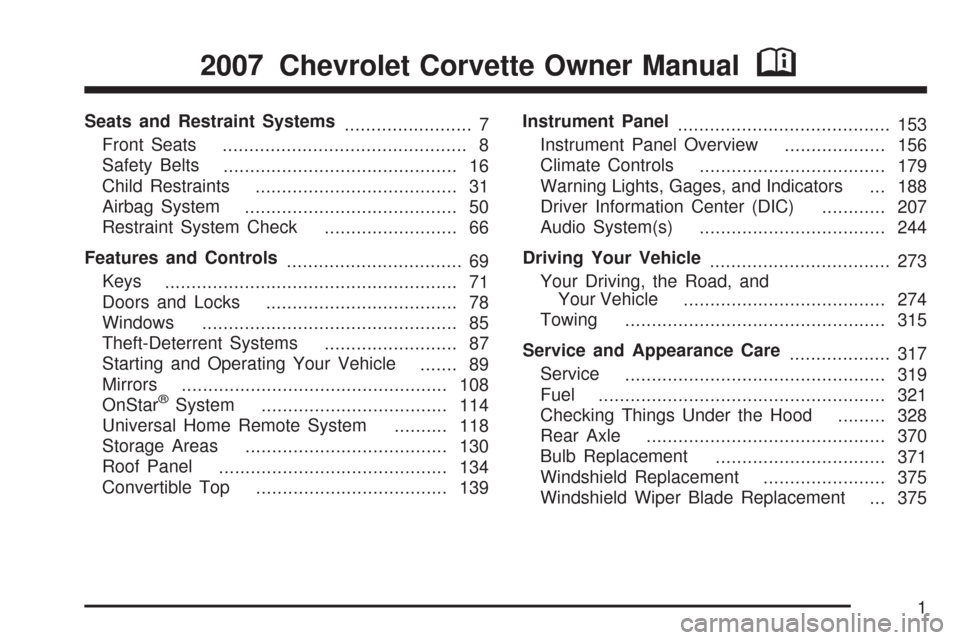
Seats and Restraint Systems
........................ 7
Front Seats
.............................................. 8
Safety Belts
............................................ 16
Child Restraints
...................................... 31
Airbag System
........................................ 50
Restraint System Check
......................... 66
Features and Controls
................................. 69
Keys
....................................................... 71
Doors and Locks
.................................... 78
Windows
................................................ 85
Theft-Deterrent Systems
......................... 87
Starting and Operating Your Vehicle
....... 89
Mirrors
.................................................. 108
OnStar
®System
................................... 114
Universal Home Remote System
.......... 118
Storage Areas
...................................... 130
Roof Panel
........................................... 134
Convertible Top
.................................... 139Instrument Panel
........................................ 153
Instrument Panel Overview
................... 156
Climate Controls
................................... 179
Warning Lights, Gages, and Indicators
... 188
Driver Information Center (DIC)
............ 207
Audio System(s)
................................... 244
Driving Your Vehicle
.................................. 273
Your Driving, the Road, and
Your Vehicle
...................................... 274
Towing
................................................. 315
Service and Appearance Care
................... 317
Service
................................................. 319
Fuel
...................................................... 321
Checking Things Under the Hood
......... 328
Rear Axle
............................................. 370
Bulb Replacement
................................ 371
Windshield Replacement
....................... 375
Windshield Wiper Blade Replacement
... 375
2007 Chevrolet Corvette Owner ManualM
1
Page 93 of 488
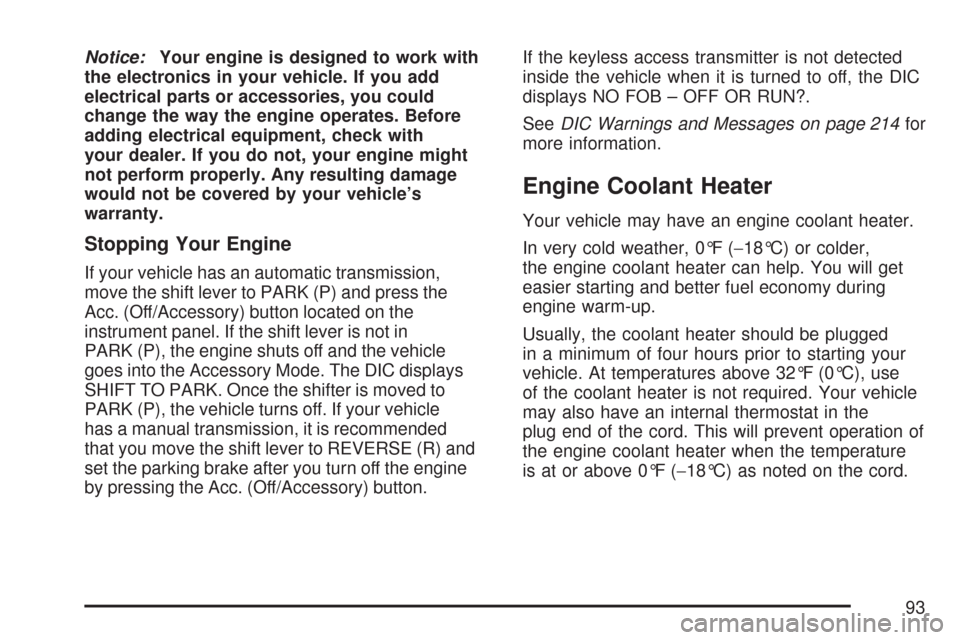
Notice:Your engine is designed to work with
the electronics in your vehicle. If you add
electrical parts or accessories, you could
change the way the engine operates. Before
adding electrical equipment, check with
your dealer. If you do not, your engine might
not perform properly. Any resulting damage
would not be covered by your vehicle’s
warranty.
Stopping Your Engine
If your vehicle has an automatic transmission,
move the shift lever to PARK (P) and press the
Acc. (Off/Accessory) button located on the
instrument panel. If the shift lever is not in
PARK (P), the engine shuts off and the vehicle
goes into the Accessory Mode. The DIC displays
SHIFT TO PARK. Once the shifter is moved to
PARK (P), the vehicle turns off. If your vehicle
has a manual transmission, it is recommended
that you move the shift lever to REVERSE (R) and
set the parking brake after you turn off the engine
by pressing the Acc. (Off/Accessory) button.If the keyless access transmitter is not detected
inside the vehicle when it is turned to off, the DIC
displays NO FOB – OFF OR RUN?.
SeeDIC Warnings and Messages on page 214for
more information.
Engine Coolant Heater
Your vehicle may have an engine coolant heater.
In very cold weather, 0°F (−18°C) or colder,
the engine coolant heater can help. You will get
easier starting and better fuel economy during
engine warm-up.
Usually, the coolant heater should be plugged
in a minimum of four hours prior to starting your
vehicle. At temperatures above 32°F (0°C), use
of the coolant heater is not required. Your vehicle
may also have an internal thermostat in the
plug end of the cord. This will prevent operation of
the engine coolant heater when the temperature
is at or above 0°F (−18°C) as noted on the cord.
93
Page 97 of 488
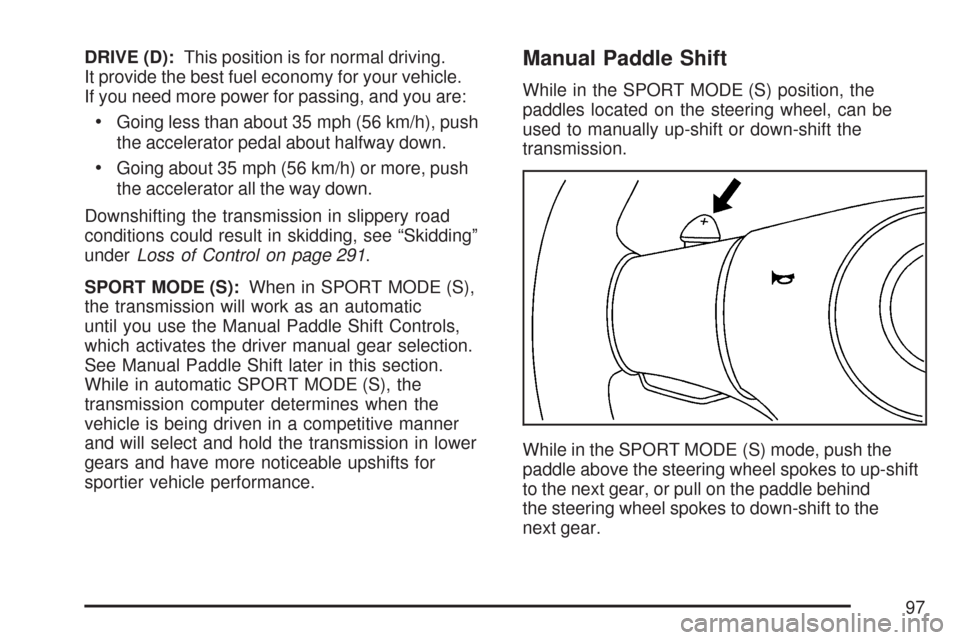
DRIVE (D):This position is for normal driving.
It provide the best fuel economy for your vehicle.
If you need more power for passing, and you are:
Going less than about 35 mph (56 km/h), push
the accelerator pedal about halfway down.
Going about 35 mph (56 km/h) or more, push
the accelerator all the way down.
Downshifting the transmission in slippery road
conditions could result in skidding, see “Skidding”
underLoss of Control on page 291.
SPORT MODE (S):When in SPORT MODE (S),
the transmission will work as an automatic
until you use the Manual Paddle Shift Controls,
which activates the driver manual gear selection.
See Manual Paddle Shift later in this section.
While in automatic SPORT MODE (S), the
transmission computer determines when the
vehicle is being driven in a competitive manner
and will select and hold the transmission in lower
gears and have more noticeable upshifts for
sportier vehicle performance.
Manual Paddle Shift
While in the SPORT MODE (S) position, the
paddles located on the steering wheel, can be
used to manually up-shift or down-shift the
transmission.
While in the SPORT MODE (S) mode, push the
paddle above the steering wheel spokes to up-shift
to the next gear, or pull on the paddle behind
the steering wheel spokes to down-shift to the
next gear.
97
Page 99 of 488
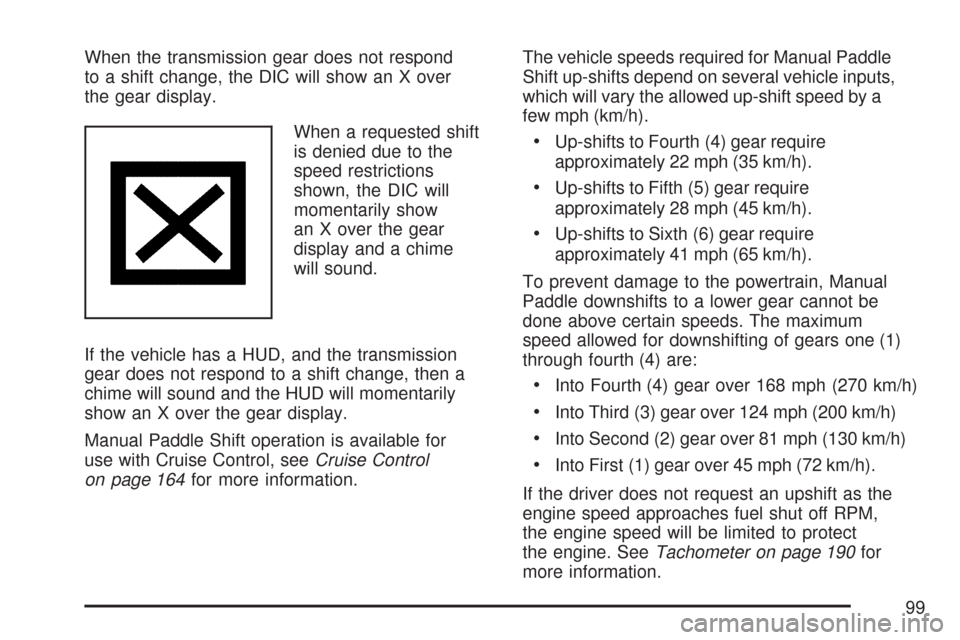
When the transmission gear does not respond
to a shift change, the DIC will show an X over
the gear display.
When a requested shift
is denied due to the
speed restrictions
shown, the DIC will
momentarily show
an X over the gear
display and a chime
will sound.
If the vehicle has a HUD, and the transmission
gear does not respond to a shift change, then a
chime will sound and the HUD will momentarily
show an X over the gear display.
Manual Paddle Shift operation is available for
use with Cruise Control, seeCruise Control
on page 164for more information.The vehicle speeds required for Manual Paddle
Shift up-shifts depend on several vehicle inputs,
which will vary the allowed up-shift speed by a
few mph (km/h).
Up-shifts to Fourth (4) gear require
approximately 22 mph (35 km/h).
Up-shifts to Fifth (5) gear require
approximately 28 mph (45 km/h).
Up-shifts to Sixth (6) gear require
approximately 41 mph (65 km/h).
To prevent damage to the powertrain, Manual
Paddle downshifts to a lower gear cannot be
done above certain speeds. The maximum
speed allowed for downshifting of gears one (1)
through fourth (4) are:
Into Fourth (4) gear over 168 mph (270 km/h)
Into Third (3) gear over 124 mph (200 km/h)
Into Second (2) gear over 81 mph (130 km/h)
Into First (1) gear over 45 mph (72 km/h).
If the driver does not request an upshift as the
engine speed approaches fuel shut off RPM,
the engine speed will be limited to protect
the engine. SeeTachometer on page 190for
more information.
99
Page 101 of 488
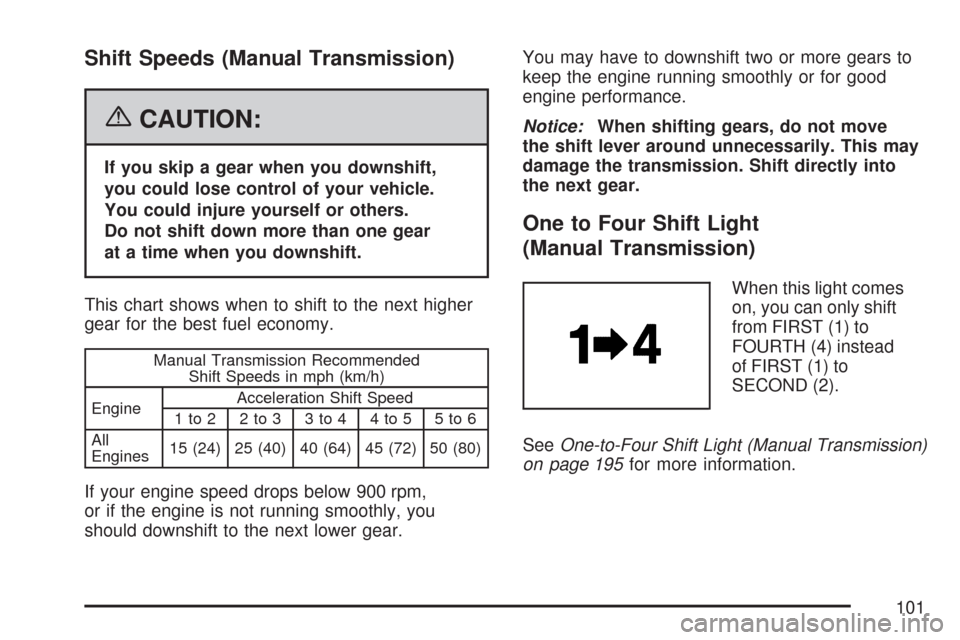
Shift Speeds (Manual Transmission)
{CAUTION:
If you skip a gear when you downshift,
you could lose control of your vehicle.
You could injure yourself or others.
Do not shift down more than one gear
at a time when you downshift.
This chart shows when to shift to the next higher
gear for the best fuel economy.
Manual Transmission Recommended
Shift Speeds in mph (km/h)
EngineAcceleration Shift Speed
1to2 2to3 3to4 4to5 5to6
All
Engines15 (24) 25 (40) 40 (64) 45 (72) 50 (80)
If your engine speed drops below 900 rpm,
or if the engine is not running smoothly, you
should downshift to the next lower gear.You may have to downshift two or more gears to
keep the engine running smoothly or for good
engine performance.
Notice:When shifting gears, do not move
the shift lever around unnecessarily. This may
damage the transmission. Shift directly into
the next gear.
One to Four Shift Light
(Manual Transmission)
When this light comes
on, you can only shift
from FIRST (1) to
FOURTH (4) instead
of FIRST (1) to
SECOND (2).
SeeOne-to-Four Shift Light (Manual Transmission)
on page 195for more information.
101
Page 154 of 488
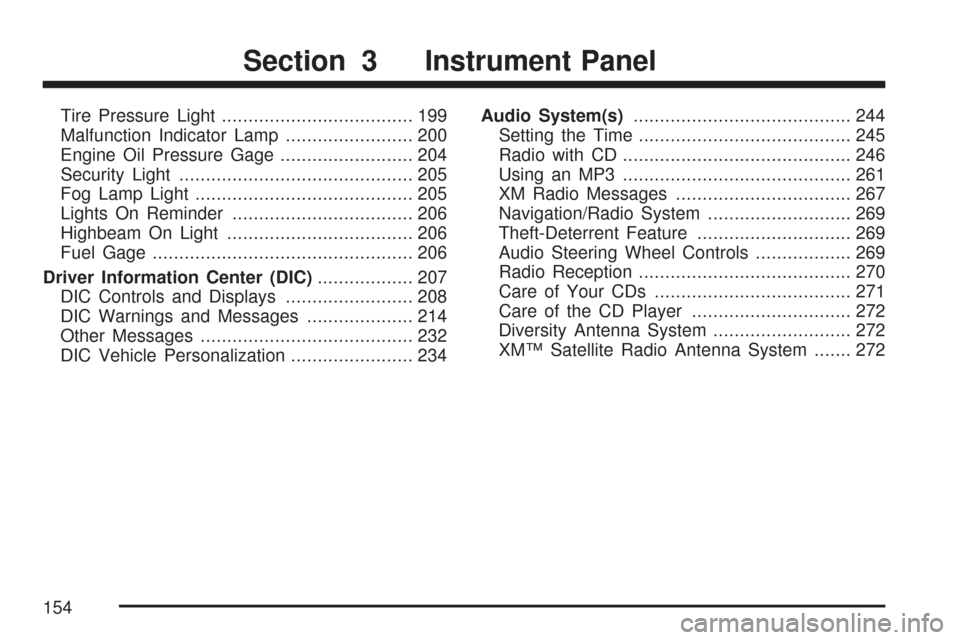
Tire Pressure Light.................................... 199
Malfunction Indicator Lamp........................ 200
Engine Oil Pressure Gage......................... 204
Security Light............................................ 205
Fog Lamp Light......................................... 205
Lights On Reminder.................................. 206
Highbeam On Light................................... 206
Fuel Gage................................................. 206
Driver Information Center (DIC).................. 207
DIC Controls and Displays........................ 208
DIC Warnings and Messages.................... 214
Other Messages........................................ 232
DIC Vehicle Personalization....................... 234Audio System(s)......................................... 244
Setting the Time........................................ 245
Radio with CD........................................... 246
Using an MP3........................................... 261
XM Radio Messages................................. 267
Navigation/Radio System........................... 269
Theft-Deterrent Feature............................. 269
Audio Steering Wheel Controls.................. 269
Radio Reception........................................ 270
Care of Your CDs..................................... 271
Care of the CD Player.............................. 272
Diversity Antenna System.......................... 272
XM™ Satellite Radio Antenna System....... 272
Section 3 Instrument Panel
154
Page 157 of 488
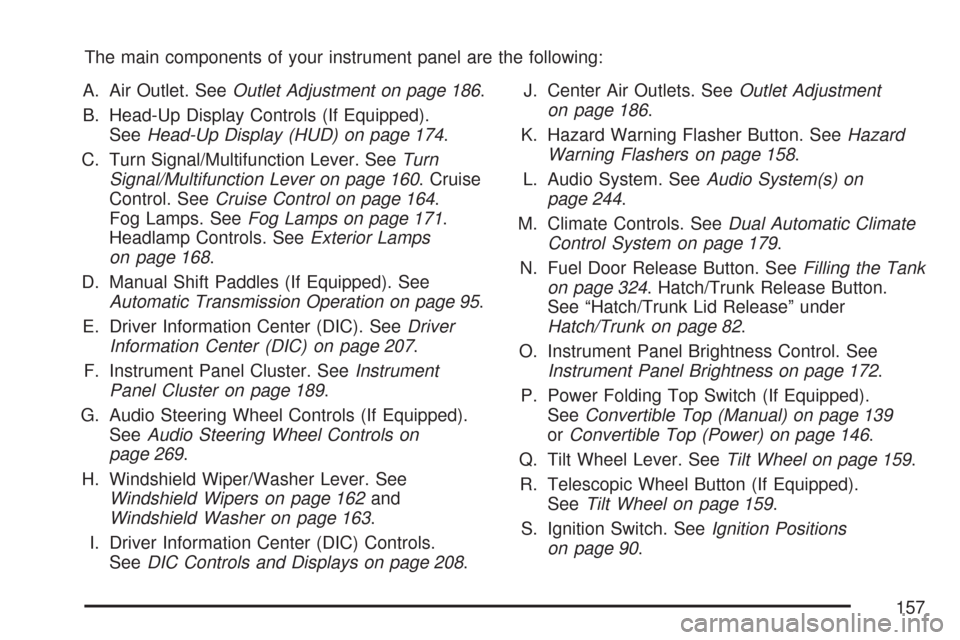
The main components of your instrument panel are the following:
A. Air Outlet. SeeOutlet Adjustment on page 186.
B. Head-Up Display Controls (If Equipped).
SeeHead-Up Display (HUD) on page 174.
C. Turn Signal/Multifunction Lever. SeeTurn
Signal/Multifunction Lever on page 160. Cruise
Control. SeeCruise Control on page 164.
Fog Lamps. SeeFog Lamps on page 171.
Headlamp Controls. SeeExterior Lamps
on page 168.
D. Manual Shift Paddles (If Equipped). See
Automatic Transmission Operation on page 95.
E. Driver Information Center (DIC). SeeDriver
Information Center (DIC) on page 207.
F. Instrument Panel Cluster. SeeInstrument
Panel Cluster on page 189.
G. Audio Steering Wheel Controls (If Equipped).
SeeAudio Steering Wheel Controls on
page 269.
H. Windshield Wiper/Washer Lever. See
Windshield Wipers on page 162and
Windshield Washer on page 163.
I. Driver Information Center (DIC) Controls.
SeeDIC Controls and Displays on page 208.J. Center Air Outlets. SeeOutlet Adjustment
on page 186.
K. Hazard Warning Flasher Button. SeeHazard
Warning Flashers on page 158.
L. Audio System. SeeAudio System(s) on
page 244.
M. Climate Controls. SeeDual Automatic Climate
Control System on page 179.
N. Fuel Door Release Button. SeeFilling the Tank
on page 324. Hatch/Trunk Release Button.
See “Hatch/Trunk Lid Release” under
Hatch/Trunk on page 82.
O. Instrument Panel Brightness Control. See
Instrument Panel Brightness on page 172.
P. Power Folding Top Switch (If Equipped).
SeeConvertible Top (Manual) on page 139
orConvertible Top (Power) on page 146.
Q. Tilt Wheel Lever. SeeTilt Wheel on page 159.
R. Telescopic Wheel Button (If Equipped).
SeeTilt Wheel on page 159.
S. Ignition Switch. SeeIgnition Positions
on page 90.
157
Page 174 of 488
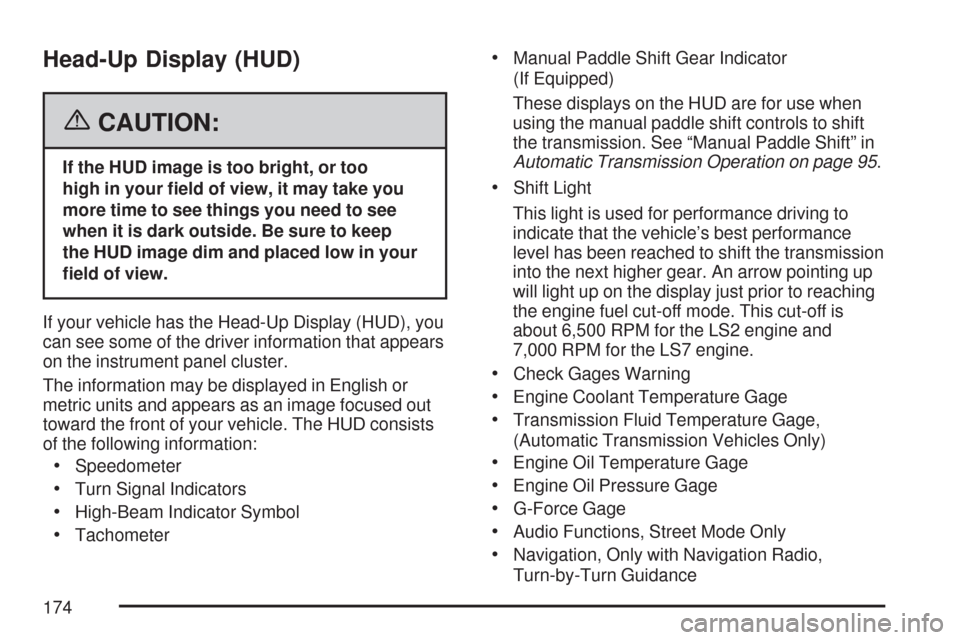
Head-Up Display (HUD)
{CAUTION:
If the HUD image is too bright, or too
high in your �eld of view, it may take you
more time to see things you need to see
when it is dark outside. Be sure to keep
the HUD image dim and placed low in your
�eld of view.
If your vehicle has the Head-Up Display (HUD), you
can see some of the driver information that appears
on the instrument panel cluster.
The information may be displayed in English or
metric units and appears as an image focused out
toward the front of your vehicle. The HUD consists
of the following information:
Speedometer
Turn Signal Indicators
High-Beam Indicator Symbol
Tachometer
Manual Paddle Shift Gear Indicator
(If Equipped)
These displays on the HUD are for use when
using the manual paddle shift controls to shift
the transmission. See “Manual Paddle Shift” in
Automatic Transmission Operation on page 95.
Shift Light
This light is used for performance driving to
indicate that the vehicle’s best performance
level has been reached to shift the transmission
into the next higher gear. An arrow pointing up
will light up on the display just prior to reaching
the engine fuel cut-off mode. This cut-off is
about 6,500 RPM for the LS2 engine and
7,000 RPM for the LS7 engine.
Check Gages Warning
Engine Coolant Temperature Gage
Transmission Fluid Temperature Gage,
(Automatic Transmission Vehicles Only)
Engine Oil Temperature Gage
Engine Oil Pressure Gage
G-Force Gage
Audio Functions, Street Mode Only
Navigation, Only with Navigation Radio,
Turn-by-Turn Guidance
174
Page 182 of 488
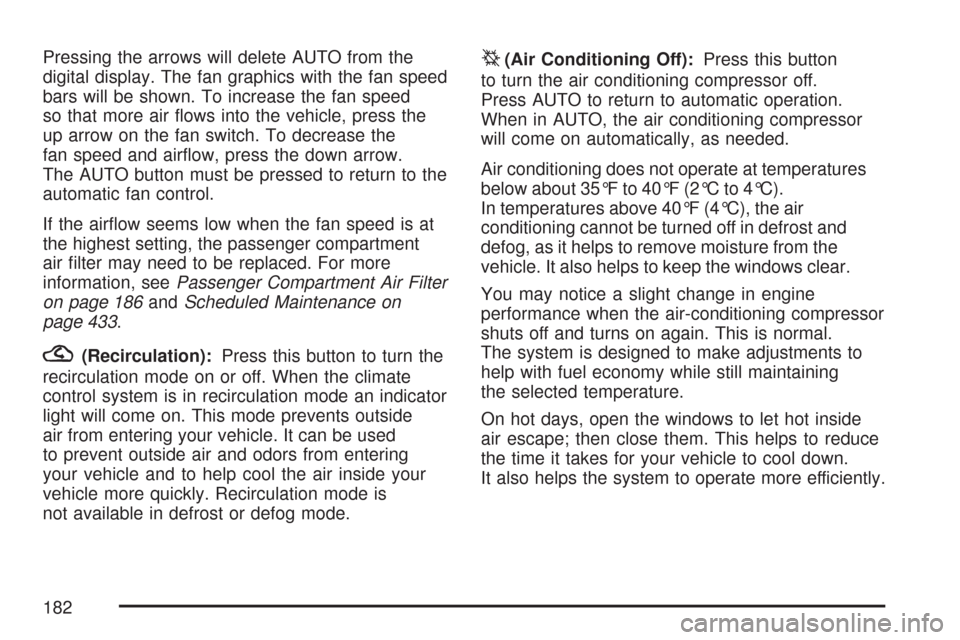
Pressing the arrows will delete AUTO from the
digital display. The fan graphics with the fan speed
bars will be shown. To increase the fan speed
so that more air �ows into the vehicle, press the
up arrow on the fan switch. To decrease the
fan speed and air�ow, press the down arrow.
The AUTO button must be pressed to return to the
automatic fan control.
If the air�ow seems low when the fan speed is at
the highest setting, the passenger compartment
air �lter may need to be replaced. For more
information, seePassenger Compartment Air Filter
on page 186andScheduled Maintenance on
page 433.
?(Recirculation):Press this button to turn the
recirculation mode on or off. When the climate
control system is in recirculation mode an indicator
light will come on. This mode prevents outside
air from entering your vehicle. It can be used
to prevent outside air and odors from entering
your vehicle and to help cool the air inside your
vehicle more quickly. Recirculation mode is
not available in defrost or defog mode.
^(Air Conditioning Off):Press this button
to turn the air conditioning compressor off.
Press AUTO to return to automatic operation.
When in AUTO, the air conditioning compressor
will come on automatically, as needed.
Air conditioning does not operate at temperatures
below about 35°F to 40°F (2°C to 4°C).
In temperatures above 40°F (4°C), the air
conditioning cannot be turned off in defrost and
defog, as it helps to remove moisture from the
vehicle. It also helps to keep the windows clear.
You may notice a slight change in engine
performance when the air-conditioning compressor
shuts off and turns on again. This is normal.
The system is designed to make adjustments to
help with fuel economy while still maintaining
the selected temperature.
On hot days, open the windows to let hot inside
air escape; then close them. This helps to reduce
the time it takes for your vehicle to cool down.
It also helps the system to operate more efficiently.
182
Page 189 of 488
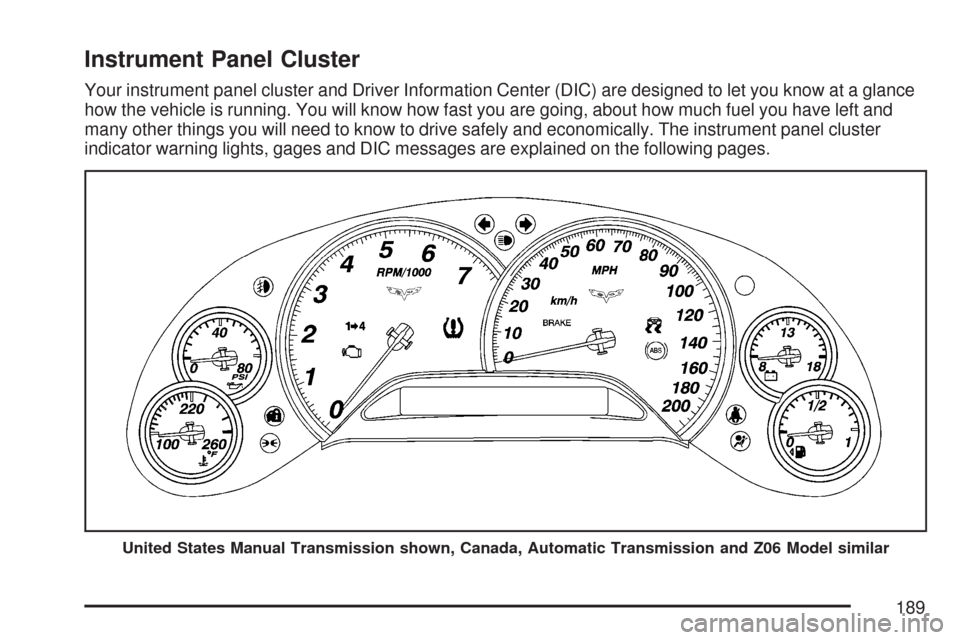
Instrument Panel Cluster
Your instrument panel cluster and Driver Information Center (DIC) are designed to let you know at a glance
how the vehicle is running. You will know how fast you are going, about how much fuel you have left and
many other things you will need to know to drive safely and economically. The instrument panel cluster
indicator warning lights, gages and DIC messages are explained on the following pages.
United States Manual Transmission shown, Canada, Automatic Transmission and Z06 Model similar
189